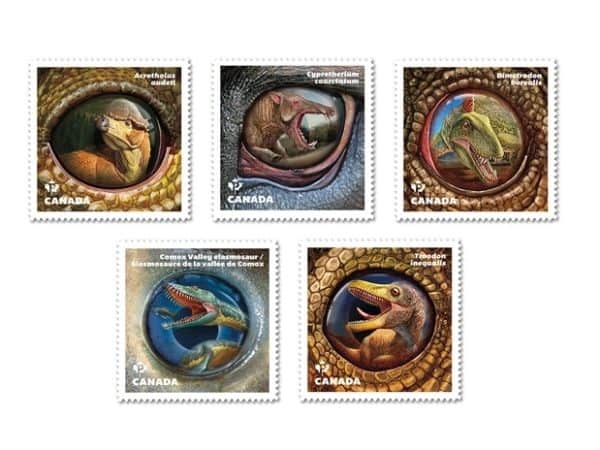
 Okay, so first things first. The dimetrodon is not really a dinosaur.
Okay, so first things first. The dimetrodon is not really a dinosaur.
That conclusion was actually reached last November in the Canadian Journal of Earth Sciences. A fossil known as Bathygnathus borealis, discovered in French River, Prince Edward Island in 1845, should actually be called a dimetrodon, said researchers.
The ancient lizard-like carnivore with the sail on its back has always been lumped in with the dinosaurs but is in fact closer in nature to a mammal and predates dinosaurs by some 50-million years.
Identity crisis or not, dimetrodon borealis is finally getting his day in the sun alongside his much younger brethren. Along with four other “beasts from Canada’s geological past”, Canada Post Thursday unveiled a stamp series called “Dinos of Canada”.
The 40mm x 40mm stamps are treated with holographic foil and multilevel embossing Canada Post says creates a three-dimensional effect and a sense of movement that suggests the creatures are breaking through the stamp.
At least one of the dinosaurs will be familiar to most everyone. Troodon inequalis is the bird-like dinosaur very similar to the velociraptor from the Jurassic Park movies. But this one didn’t live on a mysterious, fenced-in tropical island, he was a resident of Alberta’s coastal lowlands approximately 75-million years ago.
There’s also Cypretherium coarctatum, known as “terminator pigs”. They lived on the floodpolains of Saskatchewan 35-million years ago. Another fossil is so new it doesn’t yet have a geological name, but is rather known as the Comox Valley elasmosaur. It was discovered in 1988 by a father and his 12-year-old daughter prospecting for fossils in the Comox Valley.
Finally, the Acrotholus audeti was a small dinosaur that lived in Alberta about 85-million years ago.
The creatures for the stamp series were selected by the Canadian Museum of Nature and the stamps were designed in Vancouver by Subplot Design Inc from illustrations by renowned “paleo artist” Sergey Krasovskiy.
Canada’s prairie provinces, Alberta in particular, have long been rich in paleontological history. But their dominance has been challenged recently by Atlantic provinces. New discoveries in Nova Scotia have unearthed some of the country’s oldest dinosaur bones, embedded within the cliffs along the Bay of Fundy.
The study of fossils is approximately as old as the history of Canada and were paired in the personage of William Logan, a Montreal native who trained as a geologist in the U.K. Beginning in 1843, Logan began to survey Palaeozoic formations near the Eastern Townships of Québec, and in the Lake Superior area.
Eventually, Logan’s successor, John William Dawson began to make dinosaur discoveries in Alberta and Saskatchewan, a process that was hurried along by the search for oil in the areas. In the early twentieth century, F.H. McLaren provided detailed stratigraphic data that categorized fossils from the Triassic and Jurassic eras in the foothills and northern plains of Alberta. In this rich period for fossil discovery, Tyrannosaurus rex skull and skeleton discoveries were being made with regularity in Montana, South Dakota and Wyoming.
In the early 1990’s, one of the largest and most complete Tyrannosaurus rex discoveries ever unearthed happened in southwestern Saskatchewan. “Scotty”, rumored to be named for the bottle of scotch paleontologist Tim Tokaryk cracked open to celebrate the event, became one of just 12 such discoveries in the world.
Below: The Brain Scoop: Dimetrodon is Not A Dinosaur
Leave a Reply
You must be logged in to post a comment.




 Share
Share Tweet
Tweet Share
Share




Comment